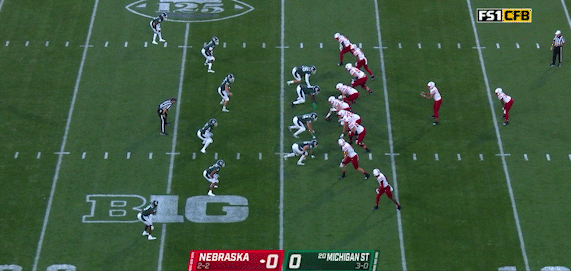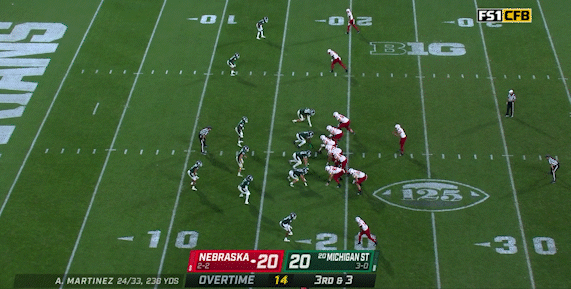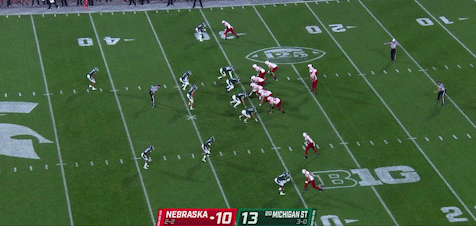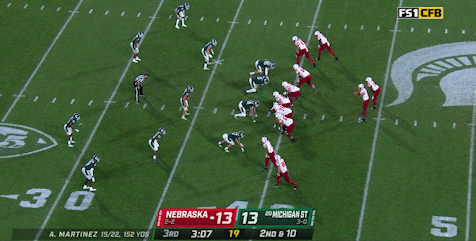MICHIGAN STATE RECAP: Kicked Again
Special teams should be banned from football, in my opinion
Basically every serious statistical football measure believes, aside from a few outliers, luck in close games is a non-controllable factor. Unless you are either an extremely good coach or an extremely terrible one, you can expect whatever variance has occurred to eventually even out in your record over time.
Well, THAT IS NOT HAPPENING!!!! After allowing a game-tying return touchdown off a shanked punt in the final minutes of regulation in Saturday’s 23-20 overtime lost to Michigan State, Nebraska fell to 5-15 under coach Scott Frost in games decided by one score. I’m not good at math, but that is … not even. Forty percent of Frost’s total games coached at Nebraska have now been one-score losses. I’m trying to think of a more brutal, punch-me-in-the-face sports tenure than this and coming up blank.
So either Frost has very deeply pissed off some god of statistics, or there are at least some systemic issues causing these close losses to occur more often than usual. The crippling mistakes in general and especially on special teams would seem to be at least part of the problem! They’ve existed for all four years, and after I initially wrote them off, they’re not going away. At some point, all the cool designed plays I like and the long-term plan for the program that I think is smart don’t matter without showing some consistent execution.
But there’s also the untidy factor that the losses ARE close. While I wanted to walk into the ocean like every other NU fan Saturday evening, this is the second straight week they’ve gone toe-to-toe with a ranked team on the road and played well enough win the game. Past coaches and past Frost teams don’t keep either of the last two weeks’ games close. That’s something that I’m not giving up on yet.
. . .
FYI: This week I talked more generally about the problems on offense and spent a little less time on the defense than I usually do because I wanted to talk about the special teams at the end (and didn’t want this to be a million words long).
OFFENSE
OFFENSIVE GAME CHART:
Google Sheet link HERE
Downloadable PDF link HERE
GAME STATISTICS:
YARDS PER PLAY: 5.13 Yards Per Play
Pregame Season Average: 6.64 yards per play (NCAA rank: 35th)
Postgame Season Average: 6.26 yards per play (NCAA rank: 44th)
National Median: 5.79 yards per play
POINTS PER DRIVE: 1.54 Points Per Drive
Pregame Season Average: 2.06 points per drive (NCAA rank: 69th)
Postgame Season Average: 1.91 points per drive (NCAA rank: 78th)
National Median: 2.14 points per drive
EXPLOSIVE PLAYS: 11 Explosive Plays (Pass: 7, Run: 4)
Pregame Season Average: 8.5 explosive plays per game
HAVOC PLAYS ALLOWED: 13 Havoc Plays allowed (15.11 percent of plays)
Pregame Season Average: 6.75 Havoc plays allowed per game
OVERVIEW:
The special teams is getting a lot of rightful flack for blowing the game, but offensive mistakes left it close enough to be blown in the first place.
Michigan State has a very good (and very aggressive) defense, but most of the errors Saturday stemmed from Nebraska’s failure to execute plays that had worked, specifically by the offensive line and the quarterback, or by dumb mistakes derailing drives.
Nebraska allowed 13 Havoc plays (tackles for loss, sacks, forced fumbles, pass breakups or interceptions) and created 11 explosive plays (runs of 12 or more yards and passes and scrambles of 16 or more yards) Saturday, both season highs. The explosives were fairly evenly distributed among the drives, but every NU drive that scored Saturday had zero or one Havoc plays allowed or penalties. “Not Doing Bad Stuff Means You Score Points” is not, like, the most groundbreaking football analysis, but the drives Nebraska scored on vs. MSU were the ones where they didn’t blow their own foot off.
The other issue here was execution. Everybody saw the offensive line get whooped on the film and saw the seven sacks on the stat sheet. They just aren’t good right now. I am semi-sympathetic: Buffalo, Oklahoma and Michigan State are probably three of the four best fronts they’ll face this season, and a hyperaggressive, amoeba defense like the Spartans’ is the worst nightmare for a young line. But the ways they’re getting beat are concerning — tackles Turner Corcoran and Bryce Benhart were big recruits who were supposed to have elite athleticism, and they’re getting beat to the edges — and the defensive fronts remaining on the schedule don’t really let up, even if the last three games were a unique challenge. Frost pointed to left guard (Ethan Piper/Trent Hixson) and right tackle (Benhart) as areas where changes might be coming, and after seeing five games of those three … yeah, I think that’s warranted at this point. But the whole unit’s play (outside of center Cam Jurgens) is killing the offensive group. I counted at least three plays on rewatch where Nebraska had receivers run free in the secondary out of initial breaks but gave up immediate pressure that doomed each play (deep routes to receiver Samori Toure and Travis Vokolek in the third quarter and to Levi Falk in overtime). You’re never going to have perfect protection, but that’s three instances where the other elements of the offense executed well enough to deliver a touchdown or big play and the offensive line couldn’t provide even a baseline level of protection or pocket for the quarterback to deliver the ball.
Speaking of the quarterback, this was … not Adrian Martinez’s best game. Or even a particularly good one. I am probably the biggest 2AM homer on the planet and he is carrying this unit on his back, so I am absolutely not trying to roast anyone, but he missed a lot of throws that could have put this game away in the second half and contributed plenty to the protection woes.
Take the game’s first sack in the first quarter:
Pistol Open Doubles WR Flex — Stick
This is a basic “Stick” concept — a short curl and a flat route where the quarterback reads one defender — primarily run when you know you’re getting off-man coverage. Stick is considered “quick game” or “0 Step” in football parlance, meaning the quarterback doesn’t take any drop out of the shotgun. His job here is to take the snap, read the one defender and throw the ball, FAST. Protection isn’t meant to hold up here, to the point a lot of teams will use cut-blocks on defensive linemen on quick game.
Everything works as it’s supposed to here and the curl comes open very cleanly, but Martinez doesn’t throw the ball on time and takes a sack. That’s a sack that is about a billion percent on the quarterback, not the offensive line.
A quick-game error also happened on the interception in overtime.
Gun Twin TE Wing WR Flex Strong — Stick/Double Slants
This is a Stick concept to one side of the formation and a “Double Slants” concept to the other, which is also quick game. Teams like Double Slants because the inside receiver often gets a free release and it’s an easy throw. Same idea here: Catch the ball, read one guy and throw. He has Omar Manning come open immediately on the inside slant, but Martinez doesn’t let it rip, Manning’s defender recovers, and a late throw is forced to a receiver who’s defender has plenty of time to recover.
That’s a really bad decision.
Martinez has always been a quarterback who needs to see a receiver open before he throws; part of that is good and why he throws so few interceptions. And again, I’m not trying to drop the hammer on him because he’s improved a lot as a decision-maker the past two years and has been awesome and exciting this year. But his issues in quick game are also intertwined with a lot of the protection issues Nebraska is having.
PROTECTION PROBLEMS:
Let’s talk about pass protections. Pass protection is the biggest difficulty in running a spread offense. With the formations being more spread and open in physical space and the substitution of receivers for the better-blocking tight ends and fullbacks of more traditional offenses, you lose a lot of ability to protect yourself against a pass rush.
There are a pretty wide variety of protections popular in a spread offense, but two of the main ones are “Man” and “Slide”. Each has a ton of different rules and variables, but in the plainest terms here they are:
“Man protection” is exactly what it sounds like: The five offensive lineman are responsible for specific individual defensive linemen or forming double teams on them with checks for blitzing linebackers.
“Slide protection” is a zone protection with linemen moving laterally, or, “sliding,” a certain direction with rules for rushers crossing linemen’s face. Often teams will run a “half slide,” where three linemen move one way, the other two stay put, and a running back or tight end cleans up the edge.
Man pro is the barest-bones protection you can use — you’re only blocking with your five offensive linemen. You can’t use fewer blockers. The upside is that it allows you to get the most possible eligible receivers out in routes, allowing you to punish teams that blitz by throwing hot routes into vacated areas or hitting monster plays. LSU in 2019 with Joe Burrow was famous for using Man pro essentially all the time; it’s great to run if you have (a) the fastest-processing quarterback in a decade who also happens to be a pocket-movement savant, and (b) 159 Monstar receivers on your roster.
Last season, Nebraska ran Man pro at the seventh-highest rate nationally. So far, they’ve kept it up this year, running it on all but 10 dropbacks this season. NU usually has the running back check for blitzers before they release into the flat, so sometimes it does end up being a six-man protection. But the point stands: They’re not leaving many people in to protect.
Man pro is great if you have the things listed above as with LSU and an OFFENSIVE LINE THAT CAN HANDLE PEOPLE ONE-ON-ONE. Nebraska has none of that. Martinez’s issues on quick game were discussed earlier, the Husker receivers are pretty good but not significantly better than their opposing secondary, and the offensive line is getting destroyed. MSU rushed four on about 78 percent of its plays Saturday. Really think about that — they were doing that much damage without even blitzing.
Frost probably was able to get away with running Man pro so much with Oregon’s talent and at UCF facing American Conference competition. And I get why he wants to do it; it allows you to be so much more creative in the passing game than heavy protections where you can only get three eligibles out in routes. But every coach WANTS to use Man pro all that time; that doesn’t mean it’s a responsible way to do things or the best thing for your team. And it’s clearly not working for 2021 Nebraska.
There are some things the staff can do differently to help out the offensive line. Keeping more people in is very obvious. They can also use “chip blocks” — where a back or tight end will briefly stay in to clip a rusher before releasing into their route — as a kind of middle ground to help out their struggling tackles and keep from running being limited to two-man route combos.
To be fair, they did show a formation/look in the OU game where they provided a chip with tight end Austin Allen before releasing out.
Gun Two-Back Y Offset — Smash
Watch Allen, lined up initially in the backfield to the field, “chip” the edge rusher to help the tackle before releasing on his route. These are the things NU should be doing to help a struggling line. I didn’t see this at all in the MSU game. They left people on an island to get beat by four-man rushes. Something with the protection needs to change.
A COOL PLAY:
The Zone Triple Option and Split Zone Triple Option out of the wide receiver Orbit motion have been among the Huskers’ best offensive plays this season. But as we saw in the Oklahoma recap, teams have been coming up with answers for it in recent weeks. Nebraska showed a couple of nice play action looks off Saturday as a counter.
Gun Doubles Y Wing Strong — Orbit PA Zone Triple Option Sail
This was their first play out of halftime. It works because Allen’s job on the triple option play is to get to the linebacker, so the “stem” of his route looks just like he would if he were blocking. He then breaks outside on a “Sail” concept — a clearout by the widest receiver with an outside breaking route from the inside receiver — and the corner is in terrible position to recover because of the initial run fit. They tried this play again two plays later and also whiffed the throw. The Huskers tried a different variation of play action off the Orbit Triple Option look on the next drive:
Gun Doubles Tight Double Flex — Orbit PA Zone Triple Option Crossers Vert Release
Here, they run deep crossers with the tight end Vokolek and Toure out of the slot. Toure doesn’t continue the crosser, though, he cuts it upfield in between the defenders. This is one of the three plays I mentioned earlier are probably touchdowns with better protection — watch Vokolek run wide open here after the safety bites on the run fake.
DEFENSE
DEFENSIVE GAME CHART:
Google Sheet link HERE
Downloadable PDF link HERE
STATISTICS:
YARDS PER PLAY ALLOWED: 4.79 Yards Per Play Allowed
Pregame Season Average: 5.00 yards per play allowed (NCAA rank: 55th)
Postgame Season Average: 4.97 yards per play allowed (NCAA rank: 48th)
National Median: 5.19 yards per play allowed
POINTS PER DRIVE ALLOWED: 1.23 Points Per Drive Allowed
Pregame Season Average: 1.41 points per drive allowed (NCAA rank: 24th)
Postgame Season Average: 1.36 points per drive allowed (NCAA rank: 19th)
National Median: 2.13 points per drive allowed
HAVOC PLAYS: 13 Havoc Plays (24.52 percent of plays)
Pregame Season Average: 11.25 Havoc plays per game
EXPLOSIVE PLAYS ALLOWED: 5 Explosive Plays Allowed (Pass: 4, Run: 1)
Pregame Season Average: 6 explosive plays allowed per game
OVERVIEW:
I’m frankly running out of superlatives for the Blackshirts. Since about the middle of the second quarter of the Fordham game, they have been completely lights out.
MSU entered as an offense built around explosions, especially by running back Kenneth Walker III. NU held them to just five total explosive plays, only one of which came by rush and one of which came after halftime (the big run by Walker in overtime). Their one big mistake of the day came on the flea flicker touchdown — MSU and former Colorado OC Jay Johnson loves flea flickers MORE THAN ANYONE ALIVE — but that play also came on a boundary corner Cat blitz when Nebraska had exposed deep coverage. That play probably doesn’t work if Nebraska isn’t coincidentally taking a massive gamble on the same snap and has its normal deep shell set up.
The stuff they’re doing schematically isn’t groundbreaking. The heavy use of the 2-5 Nickel base is new this year, but that is more a function of getting your 11 best players on the field and matching offensive personnel than anything else, and it plays like a pretty traditional 4-2-5 defense. For the most part, it’s a pretty simple gameplan: ( a ) be extremely physical and aggressive in the front and the secondary, ( b ) keep a deep shell over everything, even if it means getting occasionally burned or giving up some yards, and ( c ) move JoJo Domann around like a chess piece and use him to wreck stuff. You’ll notice NU’s yards per play allowed is pretty average while the points per drive is really good. That’s some luck, but also a little bit by design.
Two individual players who had great games Saturday were Cam Taylor-Britt and Garrett Nelson. Taylor-Britt had been in the doghouse a bit for punt-return mistakes and uncharacteristic play at corner, but he looked like his old self Saturday, allowing one catch for 7 yards on four targets, primarily matched up with Jalen Nailor, a really good and fast receiver. Nelson was an absolute demon against the MSU line, generating five total pass rush pressures and four quarterback hurries per PFF. After a rough start to his Husker career, he has really turned into one of the defense’s most disruptive players.
One very small brake-pumping: A decent amount of MSU not scoring in the second half was on them not executing. Not taking away anything from a TRULY BALLER performance from the Blackshirts, but there was meat on the bone for the Spartans to take, especially in the passing game. Payton Thorne missed a lot of throws. I don’t really know what drugs Pat Fitzgerald was on when he said this.
… It was one of the most dominant defensive performances that I’ve seen the Big Ten in a long time. I mean, that was incredibly impressive, and I think Michigan State’s outstanding on offense. ... I think they put everybody else in the Big Ten on notice last weekend.
As I said earlier, I’m skimping on defense a little this week because I feel as if this there are a few pressing things to say about special teams. But the Blackshirts will FOR SURE get their props in future newsletters.
SPECIAL TEAMS
I haven’t talked about special teams thus far in newsletter, simply because I don’t know much about them. When I coached in college, my contribution to the special teams periods of practice was largely holding up cards for the scout team return or kick units to get lined up so that they could get pulverized by the starters. So I don’t really know a ton about them, and talking about things I don’t know about is not really something I’m super interested in doing here.
But I do have SOME organizational/procedural insights into how special teams are typically run at a college level, and with the third phase costing NU yet another game, I wanted to clear up a few points I’ve seen.
First, “special teams coaching” or coordinating is largely dealing with the coverage and return units. The specialists — the actual kickers and punters and long snappers who kick and punt and long snap the ball — enter your program with those skills developed formed, for better or worse. They might improve through individual work in summers or with personal kicking coaches or by getting in the weight room, but Mike Dawson, Nebraska’s special teams coordinator, is not instructing Daniel Cerni to change his leg angle on his punts or helping Connor Culp on his accuracy; he’s lining up rush lanes on a return unit or showing blockers how to set a wall. The only football coach I’ve heard of working with kickers or punters was all-time weirdo Bob Diaco, who for some reason knew a lot about punting. But that’s a big rarity/outlier.
This would tell us, then, that NU’s problems with specialists are acquisitional, in that the staff isn’t bringing good specialists into the program.
Looking at their specific moves from the past couple years, I can’t find obvious malpractice. They knew they had a big issue at placekicker following 2019 after the injury/dismissal of Barret Pickering, so they brought in Culp from LSU, as well as a host of others to compete. Culp was all-conference in 2020, so I don’t really see how you can find fault them there. He can’t kick now. I don’t know why, but I don’t think that’s on the staff if already demonstrated he could do it in previous seasons. At punter, they wanted an upgrade for Will Przystup, so they went out and did the Australian punter pipeline thing with Cerni and offered him a scholarship — a rarity for specialists — so the allocation of resources is there, at least. The Australian punter move has been awesome for basically every program that’s done it, but this one hasn’t worked. Again, don’t know why. But you can’t really say they didn’t put resources in or pay attention to it
Second, Nebraska’s problems on special teams this year haven’t really been the coverage units, which were horrible in Frost’s first three years but have shown actual improvement this year. Before Saturday, the long return on a punt or kick was OU taking a kickoff back to its own 35. The touchdown return against MSU was not a coverage unit issue; it was caused by a punter shanking a ball to the wrong side of the field where no Nebraska coverage players were. The return units’ issues haven’t actually returned many kicks, so it’s tough to tell if there’s been any progress there. The muffs by the punt returners is obviously a huge deal, but those are decisions of an individual returner, not necessarily on the entire return unit.
Third, after four years, I think it’s fairly obvious the problems are systemic, somewhere. Some coaches, year-over-year, are good at coaching special teams. Bo Pelini was straight-up awesome at special teams for almost his entire Nebraska tenure. It’s not a fluke or luck thing; it’s a translatable, repeatable benefit some coaching staffs can elicit.
The Frost regime has shown the opposite. I have, straight-up, no idea why. But I am certain it isn’t because they “don’t care” or aren’t practicing it or aren’t devoting resources to it. Maybe their coaching points aren’t good, or their schemes are unsound, or they are playing the wrong personnel, or don’t have the right level of accountability. But anyone who thinks it’s because they “don’t care” is someone deeply unfamiliar with how a college football program is actually run or what coaches spend their time doing.
As always, thanks for reading. If you’re enjoying this newsletter, I’d appreciate sharing with anyone else who may be interested by using the link below. These are fairly time-consuming to chart and write, but I’m enjoying the hell out of sharing all this stuff and hopefully helping people learn some new things. Losing all these games is beyond frustrating and ~ slightly depressing ~ but the Huskers have been my favorite sports team since I could breathe, and there’s probably never going to be a day when I’m not excited to watch them or talk about them. I don’t know where the rest of the season goes, but I, personally, am going to just enjoy watching my No. 1 homies play seven more games. GBR.










